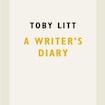
“The notebooks of a writer,” wrote Susan Sontag in 1963, “have a very special function […] Typically, writers’ notebooks are crammed with statements about the will: the will to write, the will to love, the will to renounce love, the will to go on living. The journal is where a writer is heroic to himself.”
I had this quotation to hand because it appears, in scribbled form, on the first page of my current notebook. Actually it appears on the first page of quite a few of the notebooks I’ve kept over the years, often alongside a line of Kafka’s: “A journal is an axe for the frozen sea within.” These are pretentious invocations, to be sure – especially when they launch a notebook that usually ends up crammed not with heroic statements about the will but with depressive maunderings about my inability to write, or fancy descriptions of the weather that would prove instantly fatal to any actual paragraph of fiction they appeared in (“Fog: the blurred street lamps, with their cometary tails of light”), or To Do lists (“Online health & safety training NB”). But what are notebooks for, if not big promises and small fulfilments?
The notebook, like the diary, is a physical totem of the unseen self, an external hard drive on which you can back up your inner life. Ideally, the notebook records inspirations, perceptions, eurekas; the diary, plodding along day by day, is for quotidiana. But the lines blur – especially when the inner life in question belongs to a writer. Virginia Woolf’s diaries (crammed with statements about the will to write) notate inspiration after inspiration as they track the ordinary: “have wasted the brilliant first of May which makes my skylight blue and gold; have only a rubbish heap in my head […]”
The notebooks and diaries of writers exert a special fascination, because writers are people who live almost entirely by and for their inner lives. A Writer’s Diary: the title promises something specific. The writer’s project is rivalrous. Life – the succession of days – exists not just to be lived but to be competed with, transformed, replaced, reimagined. Written, in other words. (In other words.) The notebook or diary is the staging-ground for the writer’s struggle with the real.
READ MORE
A Writer’s Diary is the title under which Leonard Woolf published an edited selection of Virginia’s journals in 1953; it is also the title of the column Dostoyevsky wrote for the Russian journal The Citizen between 1873 and 1881. A Writer’s Diary is therefore a classic title and, like all classic titles, it names a genre. Toby Litt knows this. His own writer’s diary self-consciously occupies its place in a literary genealogy. It is both diary and notebook – tracking the ordinary, recording (or forcing) inspirations. It shades gradually into fiction as it covers a year (which year? Slyly, Litt doesn’t tell us; though the published book is derived from his Substack, also called A Writer’s Diary, on which he has been posting daily entries since January 2022). It is therefore not quite a notebook, not quite a diary, not quite a novel; but has elements, sometimes ghostly elements, of all three.
The About page of Litt’s Substack describes A Writer’s Diary as “a work of what Werner Herzog calls ‘ecstatic truth’.” By this phrase Herzog meant to suggest that mere veracity – pointing a camera at what really happens – gets you nowhere. There must be transfiguration (art, rather than journalism). So we must not take Litt’s diary as an actual diary. It is not a project of self-improvement or of autobiography but an aesthetic object. It uses the gossipy lure of the diary form – read all about the writer’s secret inner life! – to get at larger, and smaller, subjects.
A Writer’s Diary owes something to the French Oulipo movement, which advocates imposing rigorous formal constraints on fiction; hence, Litt writes a page per day, no more
Litt is an interesting writer, not least because he arrived in the 1990s as a mainstream Hot Young Novelist (he was chosen as one of Granta’s Best of Young British Writers in 2003) and has since become more overtly un-mainstream – moving, for instance, to excellent indie publishers such as Galley Beggar Press, and writing books that develop the obvious-in-retrospect Euro-experimental aspects of the earlier work. A Writer’s Diary owes something to the French Oulipo movement, which advocates imposing rigorous formal constraints on fiction; hence, Litt (or “Litt”) writes a page per day, no more. It also owes something to the mid-century nouveau roman, with its deep-focus descriptions of objects and rooms (praising a student’s work, “Litt” writes: “small details well seen. And why might I like that?”
Because that’s his project, here. Microscopic descriptions of his desk, his notebooks. The materiality of being a writer – the trappings and textures: this is Litt’s subject. A way of getting at the mysteries. As in any writer’s notebook, there are fragments of beautiful perception – the room in which “Litt” teaches, for instance, is “salad-compartment chilly”. The prose veers between merely denotative (diaristic) and lyrical. In the background, daily life trundles on: “Litt”'s partner is pregnant; his mother has cancer; his novel progresses.
There are dull spots – of course there are. It’s part of the point – this is a writer’s diary. And besides, in such a rich and risky book, the odd dull page is a small price to pay.
Kevin Power’s White City is out now in paperback from Scribner UK












